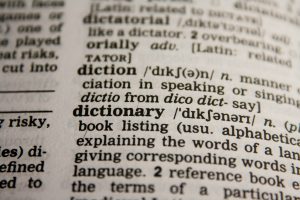12 Read: Deeper Dive into Special Occasion Speaking
Special Occasion Speaking
The materials below are attributed fully from the free online Open Education Resource, Exploring Public Speaking: The Free Dalton State College Public Speaking Textbook, 4th Edition in their Chapter 15 materials.
 Learning Objectives
Learning Objectives
After reading this chapter, the student will be able to
- Understand the differences between research-based speeches (informative and persuasive) and special occasion speeches;
- Identify the types of special occasion speeches;
- Use language to create emotional and evocative phrases;
- Understand the proper techniques for delivering a special occasion speech.
Chapter Preview
- Section 1 – Understanding Special Occasion Speeches
- Section 2 – Types of Special Occasion Speeches
- Section 3 – Special Occasion Language
- Section 4 – Special Occasion Delivery
Section 1 – Understanding Special Occasion Speeches

Often the speaking opportunities life brings our way have nothing to do with specifically informing or persuading an audience; instead, we are commonly asked to speak during special occasions in our lives. Whether you are standing up to give a speech at an awards ceremony or a toast at a wedding, knowing how to deliver speeches in a variety of different contexts is the nature of special occasion speaking. In this chapter, we are going to explore what special occasion speeches are as well as a number of types of special occasion speeches ranging from humorous to somber.
In broad terms, a special occasion speech is a speech designed to designed to address and engage the context and audience’s emotions on a specific occasion. Like informative or persuasive speeches, special occasion speeches should communicate a clear message, but the manner of speaking used is typically different. The word “special” in the term “special occasion speeches” is somewhat subjective in that while some speaking occasions truly are special occasions (e.g., a toast at a wedding, an acceptance speech at an awards banquet, a eulogy for a loved one), they can also be given at more mundane events, such as the hundreds of public relations speeches that big companies give every day. The goal of a special occasion speech is ultimately to stir an audience’s emotions and make them feel a certain way in response to the situation or occasion.
Of all the types of speeches we are most likely to have to give during our lives, many of them will fall into the special occasion category. These often include speeches that are designed to inspire or motivate an audience to do something. These are, however, different from a traditional persuasive speech. Let’s say you’re the coach of your child’s Little League team or a project leader at your work. In both cases you might find yourself delivering a speech to motivate and inspire your teams to do their best. You can imagine how giving a motivational speech like that would be different from a traditional persuasive speech, focusing on why a group of 50-somethings should change their investment strategy or a group of your peers to vote for a certain candidate for Student Senate.
To help us think through how to be effective in delivering special occasion speeches, let’s look at four key ingredients: preparation, adaptation to the occasion, adaptation to the audience, and mindfulness about the time.
Be Prepared
First, and foremost, the biggest mistake you can make when standing to deliver a special occasion speech is to underprepare or simply not prepare at all. We’ve stressed the need for preparation throughout this text, so just because you’re giving a wedding toast or a eulogy doesn’t mean you shouldn’t think through the speech before you stand up and speak out. If the situation is impromptu, even jotting some basic notes on a napkin is better than not having any plan for what you are going to say.
Adapt to the Occasion
Not all content is appropriate for all occasions. If you are asked to deliver a speech commemorating the first anniversary of a school shooting, then obviously using humor and telling jokes wouldn’t be appropriate. But some decisions about adapting to the occasion are less obvious. Consider the following examples:
- You are the maid of honor giving a toast at the wedding of your younger sister.
- You are receiving a Most Valuable Player award in your favorite sport.
- You are a sales representative speaking to a group of clients after a mistake has been discovered.
- You are a cancer survivor speaking at a high school student assembly.
- You are giving an after-dinner speech to the members of your fraternity.
How might you adapt your message and speaking style to successfully convey your message to these various audiences?
Remember that being a competent speaker is about being both personally effective and socially appropriate. Different occasions will call for different levels of social appropriateness. One of the biggest mistakes entertaining speakers can make is to deliver one generic speech to different groups without adapting the speech to the specific occasion. In fact, professional speakers always make sure that their speeches are tailored for different occasions by getting information about the occasion from their hosts. When we tailor speeches for special occasions, people are more likely to remember those speeches than if we give a generic speech.
Adapt to Your Audience
Once again, we cannot stress the importance of audience adaptation enough in this text. Different audiences will respond differently to speech material, so the more you know about your audience, the more likely you’ll succeed in your speech. One of our coauthors was once at a conference for teachers of public speaking. The keynote speaker stood and delivered a speech on the importance of public speaking. While the speaker was good and funny, the speech really fell flat. The keynote speaker basically told the public speaking teachers that they should take public speaking courses because public speaking is important. Right speech, wrong audience!
Be Mindful of the Time
The last major consideration for delivering special occasion speeches successfully is to be mindful of your time. Different speech situations have their own conventions and rules with regard to time. Acceptance speeches and toasts, for example, should be relatively short (typically under two minutes). A speech of introduction should be extremely brief—just long enough to tell the audience what they need to know about the person being introduced in a style that prepares them to appreciate that person’s remarks. In contrast, commencement speeches, eulogies, and speeches to commemorate events can run ten to twenty minutes in length, depending on the context.
It’s also important to recognize that audiences on different occasions will expect speeches of various lengths. For example, although it’s true that graduation commencement speakers generally speak for ten to twenty minutes, the closer that speaker heads toward twenty minutes the more fidgety the audience becomes. To hold the audience’s attention, a commencement speaker would do well to make the closing minutes of the speech the most engaging and inspiring portion of the speech. If you’re not sure about the expected time frame for a speech, ask the person who has invited you to speak.
Section 2 – Types of Special Occasion Speeches
Speeches of Introduction
 The first type of special occasion speech is the speech of introduction, which is a mini-speech given by the host of a ceremony that introduces another speaker and their speech. Few things are worse than when the introducer of a speaker stands up and says, “This is Wyatt Ford. He’s going to talk about stress.” While we did learn the speaker’s name and the topic, the introduction falls flat. Audiences won’t be the least bit excited about listening to Wyatt’s speech.
The first type of special occasion speech is the speech of introduction, which is a mini-speech given by the host of a ceremony that introduces another speaker and their speech. Few things are worse than when the introducer of a speaker stands up and says, “This is Wyatt Ford. He’s going to talk about stress.” While we did learn the speaker’s name and the topic, the introduction falls flat. Audiences won’t be the least bit excited about listening to Wyatt’s speech.
Just like any other speech, a speech of introduction should be a complete speech and have a clear introduction, body, and conclusion—and you should try to do it all in under two minutes. This brings up another “few things are worse” scenario: an introductory speaker who rambles on for too long or who talks about himself or herself instead of focusing on the person being introduced.
For an introduction, think of a hook that will make your audience interested in the upcoming speaker. Did you read a news article related to the speaker’s topic? Have you been impressed by a presentation you’ve heard the speaker give in the past? You need to find something that can grab the audience’s attention and make them excited about hearing the main speaker.
The body of your speech of introduction should be devoted to telling the audience about the speaker’s topic, why the speaker is qualified, and why the audience should listen (notice we now have our three main points). First, tell your audience in general terms about the overarching topic of the speech. Most of the time as an introducer, you’ll only have a speech title and maybe a paragraph of information to help guide this part of your speech. That’s all right. You don’t need to know all the ins and outs of the main speaker’s speech; you just need to know enough to whet the audience’s appetite. Next, you need to tell the audience why the speaker is a credible presenter on the topic. Has the speaker written books or articles on the subject? Has the speaker had special life events that make him or her qualified? Lastly, you need to briefly explain to the audience why they should care about the upcoming speech. The outline can be adjusted; for example, you can give the biographical information first, but these three areas should be covered.
The final part of a good introduction is the conclusion, which is generally designed to welcome the speaker to the platform. Many introducers will conclude by saying something like, “I am looking forward to hearing how Wyatt Ford’s advice and wisdom can help all of us today, so please join me in welcoming Dr. Wyatt Ford.” At this point, you as the person introducing the speaker are “handing off” the speaking duties to someone else, so it is not uncommon to end your speech of introduction by clapping as the speaker comes on stage or shaking the speaker’s hand.
Speeches of Presentation

The second type of special occasion speech is the speech of presentation. A speech of presentation is a brief speech given to accompany a prize or honor. Speeches of presentation can be as simple as saying, “This year’s recipient of the Lavache Public Speaking prize is Ryann Curley,” or could last up to five minutes as the speaker explains why the honoree was chosen for the award. An interesting example of a speech presenting an award is this one by Zoe Saldana for J.J. Abrams (https://www.youtube.com/watch?v=x03cGSszr8Q).
When preparing a speech of presentation, it’s always important to ask how long the speech should be. Once you know the time limit, then you can set out to create the speech itself. First, you should explain what the award or honor is and why the presentation is important. Second, you can explain what the recipient has accomplished in order for the award to be bestowed. Did the person win a race? Did the person write an important piece of literature? Did the person mediate conflict? Whatever the recipient has done, you need to clearly highlight their work. Lastly, if the race or competition was conducted in a public forum and numerous people didn’t win, you may want to recognize those people for their efforts as well. While you don’t want to steal the show away from winner, you may want to highlight the work of the other competitors or nominees.
Speeches of Acceptance
The complement to a speech of presentation is the speech of acceptance. The speech of acceptance is a speech given by the recipient of a prize or honor. There are three typical components of a speech of acceptance: 1) thank the givers of the award or honor, 2) thank those who helped you achieve your goal, and 3) put the award or honor into perspective. First, you want to thank the people who have given you the award or honor and possibly those who voted for you. We see this done every year during the Oscars, “First, I’d like to thank the Academy and all the Academy voters.”
Second, you want to give credit to those who helped you achieve the award or honor. No person accomplishes things in life on their own. We all have family members, friends, and colleagues who support us and help us achieve what we do in life, and a speech of acceptance is a great time to graciously recognize those individuals. Lastly, put the award in perspective. Tell the people listening to your speech why the award is meaningful to you. If you know you are up for an award, the odds of your winning are high. In order to avoid blubbering through an acceptance speech, have one ready. A good rule to remember is: Be thankful, be gracious, be short.
Speeches of Dedication
A fourth special occasion speech is the speech of dedication. A speech of dedication is delivered when a new store opens, a building is named after someone, a plaque is placed on a wall, a new library is completed, and so on. These speeches are designed to highlight the importance of the project and possibly those to whom the project has been dedicated.
When preparing a speech of dedication, start by explaining how you are involved in the dedication. If the person to whom the dedication is being made is a relative, tell the audience about your relationship and your relative’s accomplishments. Second, you want to explain what is being dedicated. If the dedication is a new building or a pre-existing building, you want to explain the importance of the structure. You should then explain who was involved in the project.
If the project is a new structure, talk about the people who built the structure or designed it. If the project is a pre-existing structure, talk about the people who put together and decided on the dedication. Lastly, explain why the structure is important for the community in which it is located. If the dedication is for a new store, talk about how the store will bring in new jobs and new shopping opportunities. If the dedication is for a new wing of a hospital, talk about how patients will be served and the advances in medicine the new wing will provide the community.
Toasts
At one time or another, almost everyone is going to be asked to deliver a toast. A toast is a speech designed to congratulate, appreciate, or remember. First, toasts can be delivered for the purpose of congratulating someone for an honor, a new job, or getting married. You can also toast someone to show your appreciation for something they have done. Lastly, we toast people to remember them and what they have accomplished.
When preparing a toast, the first goal is always to keep your remarks brief. Toasts are generally given during the middle of some kind of festivities (e.g., wedding, retirement party, farewell party), and you don’t want your toast to take away from those festivities for too long. Second, the goal of a toast is to focus attention on the person or persons being toasted—not on the speaker.
As such, while you are speaking, you need to focus your attention toward the people being toasted, both by physically looking at them and by keeping your message about them. You should also avoid any inside jokes between you and the people being toasted because toasts are public and should be accessible for everyone who hears them. To conclude a toast, simply say something like, “Please join me in recognizing Gina for her achievement” and lift your glass. When you lift your glass, this will signal to others to do the same and then you can all take a drink, which is the end of your speech.
Roasts
A roast is a very interesting and peculiar speech because it is designed to both praise and good-naturedly insult a person being honored. Because of this combination of purposes, it is not hard to argue that the roast is probably a challenging type of speeches to write given the difficult task of simultaneously praising and insulting the person. Generally, roasts are given at the conclusion of a banquet in honor of someone’s life achievements. The television station Comedy Central has been conducting roasts of various celebrities for a few years, and if you’ve ever watched one, you know that the “roasters” say some harsh things about the “roastees” even though they are friends.
During a roast, the roaster will stand behind a lectern while the roastee is seated somewhere where they are clearly on display for the audience to see, thus allowing the audience to take in their reactions. Since half the fun of a good roast is watching the roastee’s reactions during the roast, it’s important to have the roastee clearly visible to the audience.
How does one prepare for a roast? First, you want to really think about the person who is being roasted. Do they have any strange habits or amusing stories in their past that you can discuss? When you think through these questions, you want to make sure that you cross anything off your list that is truly private information or will really hurt the person. The goal of a roast is to poke at him, not massacre him.
Second, when selecting which aspects to poke fun at, you need to make sure that the items you choose are widely known by your audience. Roasts work when the majority of people in the audience can relate to the jokes being made. If you have an inside joke with the roastee, bringing it up during roast may be great fun for the two of you, but it will leave your audience unimpressed. Lastly, end on a positive note. While the jokes are definitely the fun part of a roast, you should leave the roastee and the audience knowing that you truly do care about and appreciate the person.
Eulogies

A eulogy is a speech given in honor of someone who has died (Don’t confuse “eulogy” with “elegy,” a poem or song of mourning). Not to sound depressing, but since everyone who is alive will someday die, the chance of your being asked to give a eulogy someday for a friend or family member is significant. However, when the time comes to deliver a eulogy, it’s good to know what you’re doing and to adequately prepare your remarks.
When preparing a eulogy, first you need to know as much information about the deceased as possible. The more information you have about the person, the more personal you can make the eulogy. While you can rely on your own information if you were close to the deceased, it is always a good idea to ask friends and relatives of the deceased for their memories, as these may add important facets that may not have occurred to you. Of course, if you were not very close to the deceased, you will need to ask friends and family for information. Second, although eulogies are delivered on the serious and sad occasion of a funeral or memorial service for the deceased, it is very helpful to look for at least one point to be lighter or humorous. In some cultures, in fact, the friends and family attending the funeral expect the eulogy to be highly entertaining and amusing.
Take, for example, Tom Arnold’s eulogy of Saturday Night Live actor Chris Farley. During his speech at Farley’s funeral, Arnold noted, “Chris was concerned about his size, and so he made sure that all of us who knew him well saw him naked at least once” (Glionna, 1998). Picturing the heavy-set comedian naked surely brought some humor to the somber proceedings, but Arnold knew Farley (and his audience) well enough to know that the story would be appropriate.
Knowing the deceased and the audience is vital when deciding on the type and amount of humor to use in a eulogy. It’s doubtful statements like Tom Arnold’s would fit many eulogies. But it would be appropriate to tell a funny story about Uncle Joe’s love for his rattletrap car or Aunt Mary’s love of tacky Christmas sweaters. Ultimately, the goal of the humor or lighter aspects of a eulogy is to relieve the tension that is created by the serious nature of the occasion.
If you are ever asked to give a eulogy, that means you were probably close to the deceased and are experiencing shock, sadness, and disbelief at your loved one’s passing. The last thing that you will want to do (or be in a mental state to do) is figure out how to structure your eulogy. To that end, here are three parts of a eulogy (i.e. main points) you can use to write one without worrying about being original with structure or organizational patterns: praise, lament, and consolation.
Praise
The first thing you want to do when remembering someone who has passed away is remind the audience what made that person so special. So you will want to praise them and their accomplishments. This can include notable achievements (being an award winner; helping with charities), personal qualities (“she was always willing to listen to your problems and help in any way she could”), or anecdotes and stories (being a great mother; how she drove to college to visit you when you were homesick).
Lament
The second thing you want to do in a eulogy is to lament the loss. To lament means to express grief or sorrow, which is what everyone at a funeral has gathered to do. You will want to acknowledge that everyone is sad and that the deceased’s passing will be difficult to get through. Here you might mention all the things that will no longer happen as a result of the death. “Now that Grandpa is gone, there won’t be any more Sunday dinners where he cooks chicken on the grill or bakes his famous macaroni and cheese.”
Console
The final step (or main point) in a eulogy is to console the audience, or to offer comfort in a time of grief. What you must remember (and many people often forget) is that a eulogy is not a speech for the person who has died; it is a speech for the people who are still living to try to help them deal with the loss. You will want to end your eulogy on a positive note. Offer some hope that someday, things will get better. If the deceased was a religious person, this is where you might want to incorporate elements of that belief system. Some examples would include ideas like:
“Jim has gone home to be with the Lord and is looking down on us fondly today.”
“We may miss Aunt Linda deeply, but our memories of her will live on forever, and her impact on this world will not soon be forgotten.”
Using the Praise-Lament-Console format for eulogies gives you a simple system where you can fill in the sections with 1) why was the person good, 2) why you will miss him or her, and 3) how you and the audience will get through this loss. It sometimes also helps to think of the three points in terms of Past-Present-Future: you will praise the deceased for what he did when he was alive (the past), lament the loss you are feeling now (the present), and console your audience by letting them know that things will be all right (the future).
With regard to a eulogy you might give in class, you generally have two options for how to proceed: you can eulogize a real person who has passed away, or you can eulogize a fictional character (if your instructor permits that). If you give a eulogy in class on someone in your life who has actually passed away, be aware that it is very common for students to become emotional and have difficulty giving their speech. Even though you may have been fine practicing at home and feel good about giving it, the emotional impact of speaking about a deceased loved one in front of others can be surprisingly powerful. Conversely, if you give a eulogy on a fictional character, you must treat your classroom assignment eulogy as you would a real eulogy. You wouldn’t make fun of or trivialize someone’s life at an actual funeral, so don’t do that in your eulogy for a serious speech assignment either.
Speeches of Farewell
A speech of farewell allows someone to say good-bye to one part of their life as they is moving on to the next part of life. Maybe you’ve accepted a new job and are leaving your current job, or you’re graduating from college and entering the work force. Periods of transition are often marked by speeches of farewell. When preparing a speech of farewell, the goal should be to thank the people in your current position and let them know how much you appreciate them as you make the move to your next position in life. Second, you want to express to your audience how much the experience has meant to you. A farewell speech is a time to commemorate and think about the good times you’ve had. As such, you should avoid negativity during this speech. Lastly, you want to make sure that you end on a high note.
Speeches for Commencements

A speech of commencement (or, as it is more commonly known, a “commencement speech”) is designed to recognize and celebrate the achievements of a graduating class or other group of people. These typically take place at graduation ceremonies. Nearly every one of us has sat through commencement speeches at some point in our lives. And if you’re like us, you’ve heard good ones and bad ones. Numerous celebrities and politicians have been asked to deliver commencement speeches at colleges and universities. A famous and well-thought-out commencement speech was given by famed Harry Potter author J. K. Rowling at Harvard University in 2008 (found at http://www.youtube.com/watch?v=nkREt4ZB-ck). Rowling’s speech has the perfect balance of humor and inspiration, which are two of the main ingredients of a great commencement speech.
If you’re ever asked to deliver a commencement speech, there are some key points to think through when deciding on your speech’s content.
- If there is a specific theme for the graduation, make sure that your commencement speech addresses that theme. If there is no specific theme, come up with one for your speech. Some common commencement speech themes are commitment, competitiveness, competence, confidence, decision making, discipline, ethics, failure (and overcoming failure), faith, generosity, integrity, involvement, leadership, learning, persistence, personal improvement, professionalism, reality, responsibility, and self-respect.
- Talk about your life and how graduates can learn from your experiences to avoid pitfalls or take advantages of life. How can your life inspire the graduates in their future endeavors?
- Make the speech humorous. Commencement speeches should be entertaining and make an audience laugh.
- Be brief! Nothing is more painful than a commencement speaker who drones on and on. Remember, the graduates are there to get their diplomas; their families are there to watch the graduates walk across the stage.
- Remember, while you may be the speaker, you’ve been asked to impart wisdom and advice for the people graduating and moving on with their lives, so keep it focused on them.
- Place the commencement speech into the broader context of the graduates’ lives. Show the graduates how the advice and wisdom you are offering can be utilized to make their own lives better.
Overall, it’s important to make sure that you have fun when delivering a commencement speech. Remember, it’s a huge honor and responsibility to be asked to deliver a commencement speech, so take the time to really think through and prepare your speech.
After-Dinner Speeches
After-dinner speeches are humorous speeches that make a serious point. These speeches get their name from the fact that they historically follow a meal of some kind. After-dinner speakers are generally asked to speak (or hired to speak) because they have the ability both to speak effectively and to make people laugh. First and foremost, after-dinner speeches are speeches and not stand-up comedy routines. All the basic conventions of public speaking previously discussed in this text apply to after-dinner speeches, but the overarching goal of these speeches is to be entertaining and to create an atmosphere of amusement.
After-dinner speaking is an extremely difficult type of speaking to do well because it is an entertaining speech that depends on the successful delivery of humor. People train for years to develop comic timing, or the verbal and nonverbal delivery used to enhance the comedic value of a message. But after-dinner speaking is difficult, not impossible. What follows is the method we recommend for developing a successful after-dinner speech.
First, use all that you have learned about informative or persuasive speeches to prepare a real informative or persuasive speech roughly two-thirds the length of what the final speech will become. That is, if you’re going to be giving a ten-minute speech, then your “real” informative or persuasive speech should be six or seven minutes in length. This is the “serious message” portion of the speech where you will try to make a point of educating your audience.
Next, go back through the speech and look for opportunities to insert humorous remarks. Once you’ve looked through your speech and examined places for verbal humor, think about any physical humor or props that would enhance your speech. Physical humor is great if you can pull it off without being self-conscious. One of the biggest mistakes any humorist makes is to become too aware of what their body is doing because it’s then harder to be free and funny. As for props, after-dinner speakers have been known to use everything from oversized inflatable baseball bats to rubber clown noses. The goal for a funny prop is that it adds to the humor of the speech without distracting from its message.
Last, and probably most important, try the humor out on real, live people. This is important for three reasons. First, the success of humor depends heavily on delivery, and especially timing in delivery. You will need practice to polish your delivery so that your humor comes across. If you can’t make it through one of your jokes without cracking up, you will need to either incorporate the self-crackup into your delivery or forgo using that joke.

Second, just because you find something unbelievably funny in your head doesn’t mean that it will make anyone else laugh. Often, humor that we have written down on paper just doesn’t translate when orally presented. You may have a humorous story that you love reading on paper, but find that it just seems to drone on once you start telling it out loud. Furthermore, remember there is a difference between written and verbal language, and this also translates to how humor is interpreted. Third, you need to make sure the humor you choose will be appropriate for a specific audience. What one audience finds funny another may find offensive. Humor is the double-edged sword of public speaking. On one side, it is an amazing and powerful speaking tool, but on the other side, few things will alienate an audience more than offensive humor. If you’re ever uncertain about whether a piece of humor will offend your audience, don’t use it.
So you may now be asking, “What kind of topics are serious that I can joke about?” The answer to that, like the answer to most everything else in the book, is dependent on your audience and the speaking situation, which is to say any topic will work, while at the same time you need to be very careful about how you choose your topic.
Take, for example, the experience one of your authors had while he was attending a large university. One of the major problems that any large university faces is parking: the ratio of parking spaces to students at some of these schools can be 1:7 (one parking space for every seven students). In addressing this topic at a banquet, a student gave an after- dinner speech that addressed the problem of the lack of student parking. To do so, he camouflaged his speech as a faux-eulogy (fake eulogy) for the yellow and black board on the parking lot gates (see Image 3.1) that was constantly and consistently driven through by students wanting to access restricted parking. The student personified the board by noting how well it had done its job and lamented that it would never get to see its little toothpick children grow up to guard the White House. But underneath the humor incorporated into the speech was a serious message: this wouldn’t keep happening if adequate parking was provided for students on campus.
Motivational Speeches

A motivational speech is designed not only to make an audience experience emotional arousal (fear, sadness, joy, excitement) but also to motivate the audience to do something with that emotional arousal. Whereas a traditional persuasive speech may want listeners to purchase product X or agree with idea Y, a motivational speech helps to inspire people in a broader fashion, often without a clearly articulated end result in mind. As such, motivational speaking is a highly specialized form of persuasive speaking commonly delivered in schools, businesses, religious houses of worship, and club or group contexts. The Toastmasters International Guide to Successful Speaking (Slutsky & Aun, 1997) lists four types of motivational speeches: hero, survivor, religious, and success.
The hero speech is a motivational speech given by someone who is considered a hero in society (e.g., military speakers, political figures, and professional athletes). Just type “motivational speech” into YouTube and you’ll find many motivational speeches given by individuals who can be considered heroes or role models.
The survivor speech is a speech given by someone who has survived a personal tragedy or who has faced and overcome serious adversity. In the following clip, cancer survivor Becky M. Olsen discusses being a cancer survivor (http://www.youtube.com/watch?v=zuo1u_C9_3g). Becky Olsen goes all over the country talking with and motivating cancer survivors to beat the odds.
The religious speech is fairly self-explanatory; it is designed to incorporate religious ideals into a motivational package to inspire an audience into thinking about or changing aspects of their religious lives. The final type of motivational speech is the success speech, which is given by someone who has succeeded in some aspect of life and is giving back by telling others how they too can be successful.
Summary
As stated at the beginning of this section, you will almost certainly be limited by your professor with regards to which of these types of speeches you can give for your special occasion speech in class, but it is not unrealistic to think that you will be called upon at various points in your life to give one or more of these speeches. Knowing the types and basic structures will help when those moments arise.
Section 3 – Special Occasion Language

Special occasion speaking is so firmly rooted in the use of good language that it makes sense to address it here, drawing from concepts in Chapter 10. More than any other category of speech, the special occasion speech is arguably one where the majority of your preparation time will be specifically allocated towards the words you choose. This isn’t to say you shouldn’t have used good language in your informative and persuasive speeches, but that the emphasis shifts slightly in a special occasion speech.
For example, for your informative and persuasive speeches you were required to conduct research and cite your sources in a bibliography or references/works cited page, which took you some time to look up and format. In most cases, that will not be necessary in a special occasion speech, although there may be reasons to consult sources or other persons for information in crafting your speech. So for special occasion speeches, there is a trade-off. The time you don’t spend doing research is now going to be reallocated towards crafting emotional and evocative phrases that convey the sentiment your speech is meant to impart.
The important thing to remember about using language effectively is that we are not talking about using big words just to sound smart. Do not touch a thesaurus! Good language isn’t about trying to impress us with fancy words. It’s about taking the words you are already comfortable and familiar with and putting them in the best possible order. Consider the following example from the then-president of the Ohio State University, Gordon Gee, giving a commencement address at Florida State University in 1997:
As you look back on your years at Florida State I hope you remember many good things that have happened. These experiences are, for the most part, events of the mind. The memories, ladies and gentlemen, however, are treasures of the heart.
Notice three things about his use of language: first, he doesn’t try to use any fancy words, which he certainly could if he wanted to. Every word in this portion of his speech is one that all of us knew by the time we left elementary school, so again, don’t mistake good language for big words. Using a five-syllable word when a two-syllable word will work just as well often means a speaker is trying too hard to sound smart. And given that the use of those big words often comes off sounding awkward or inappropriate, you’re better off just sticking with what you know.
Second, notice how he uses those basic words to evoke emotion and wonderment. Putting the words you know into the best possible order, when done well, will make your speech sound extremely eloquent and emotional. Third, he uses parallelism in this brief snippet, one of the rhetorical techniques discussed in Chapter 10. The use of “events of the mind” and “treasures of the heart” to compare what is truly important about the college experience is powerful. Indeed, Gee’s commencement address is full of various rhetorical devices, with the twelve-minute speech also containing alliteration, assonance, and antithesis.
Section 4 – Special Occasion Delivery

Just as the language for special occasion speaking is slightly different, so too are the ways in which you will want to deliver your speech. First and foremost, since you will be spending so much time crafting the perfect language to use and putting your words in the right order, it is imperative that you say exactly what you have written; otherwise, what was the point? To that end, your delivery for a special occasion speech will skew slightly more in favor of manuscript speaking discussed in Chapter 11. While it is still vital to establish eye contact with your audience and to not sound like you are reading, it is also important to get the words exactly right.
You will need to practice your special occasion speech as much as or even more than you did for your informative or persuasive speeches. You need to know what you are going to say and feel comfortable knowing what is coming next. This is not to say you should have your speech memorized, but you need to be able to take your eyes off the page in order to establish and maintain a rapport with your audience, a vital element in special occasion speaking because of the emotional component at the core of these speeches. Knowing your speech will also allow you to counteract the flow of adrenaline into your system, something particularly important given that special occasion speeches tend to be very emotional, not just for the audience, but for you as well.
Basically, knowing your speech well allows you to incorporate the emotion that a special occasion speech is meant to convey, something that is hard to do when you read the entirety of your speech. In this way your audience will sense the pride you feel for a graduating class during a commencement speech, the sorrow you feel for the deceased during a eulogy, or the gratitude you have when accepting an award.
Conclusion
Special occasion speaking is the most varied type of speaking to cover; however, there are some general rules to keep in mind regardless of what type you are engaged in. Remember that using good, evocative language is key, and that it is important that you deliver your speech in a way that both conveys the proper emotion for the occasion as well as allows you to give the speech exactly as you wrote it.
Sample Outline: Commemorative (Tribute) Speech on Simone Biles
By Kellie Barnes
Specific Purpose: To inspire my audience with the story of Simone Biles.
Introduction: “I’m not the next Usain Bolt or Michael Phelps. I’m the first Simone Biles!” Said Simone, and boy did she earn that kind of recognition! Some of you might hear that name and think of a random gymnast and some of you may hear that name and not know who it is at all; but today, before this class is over, I am going to make sure each and every one of you remember just how great she is and why she deserves to be recognized.
Thesis: A person whom I admire over all other athletes is Simone Biles.
Preview: Simone is special in my eyes because she has overcome some big challenges in her life to get to where she is today. Not only is she a 3-time gymnastics champion, but she made history while doing it.
- Simone overcame an extremely rough childhood in Columbus, Ohio, as both her mother and father were struggling with substance abuse.
- Simone’s grandparents took her and her siblings under their wings.
- Soon her grandparents were able to adopt all of the grandchildren at a fairly young age.
- Although Simone didn’t have the best relationship with her mom as a young child, she had plenty of women to step up in her life to fill that gap. Not only did s
- She had a grandmother who was basically “Mom” to her.
- She has also had the same gymnastics coach since she was 11 years old.
Transition: Although Simone had a rather disheartening childhood, she has emerged to be one of the best in her sport.
- In her teens and standing at 4 foot 8 inches, Simone made a tremendous name for herself in the gymnastics world. These are just a few of her accomplishments.
- Simone was the first female ever to win three worldwide all-around titles.
- She has the most World Championship gold medals won by a female gymnast in history with ten.
- She is the most decorated World Championship American gymnast with 14 total medals (10 gold, two silver, two bronze).
- She became the Olympic Gold medalist in vault, floor, Individual and Team all-around and Bronze medalist on Beam at 2016 Rio de Janeiro Olympics.
- At just 19 years old, she became the most decorated female gymnast in America.
- Right behind her the whole time stood her amazing family and support system.
- She is the first African American to become an all-around world champ.
- Consequently, she has received many media awards and much attention.
- She was named one of the Most Influential People in the World list by TIME magazine.
- She was named Associated Press Female Athlete of the Year 2016.
- Simone was the first female ever to win three worldwide all-around titles.
Transition: Simone was so incredibly grateful that she had people to take her in and support her through all of her success she tried her best to do the same for others who were in need.
- Simone started an amazing charity for foster kids as a way for her to give back.
- Founded in 2015, Mattress Firm Foster Kids is now effective in 40 states nationwide.
- “This is such a personal cause for me because I know first-hand what it is like to be in foster care, the struggles and all,” says Simone.
- This cause has given back more than 610,000 items, such as clothes and school supplies, to foster kids and their families.
Conclusion: As I sit back and look at the life of Simone Biles I’m amazed with all that she has done in such a short amount of time. At 20 years old she had given back to those in need, rose above many tough challenges in her life, and amongst all of that she is having the time of her life on the mat, and earning medals and honors while doing so. “I’m out here to prove what I’m capable of” said Simone and in my eyes, she is doing just that.
Chapter THREE Attribution:
Manley, J. A., & Rhodes, K. (2020). Exploring Public Speaking: The Free Dalton State College Public Speaking Textbook, 4th Edition. Manifold. Retrieved from https://alg.manifoldapp.org/read/exploring-public-speaking-the-free-dalton-state-college-public-speaking-textbook-4th-edition/
Creative Commons License

This work is licensed under a Creative Commons Attribution-NonCommercial-Share Alike 4.0 International License.
Authors and Contributors
Barbara G. Tucker (Editor and Primary Author)
As chair of the Department of Communication at Dalton State College, Dr. Tucker oversees programs in communication, general studies, music, theatre, and interdisciplinary studies. She is Professor of Communication and has worked in higher education for over 40 years. She lives in Ringgold, Georgia, with her husband; they have one son. She is a novelist and playwright. Her research areas are the basic course, open educational resources, historical perspectives on rhetoric, and gratitude.
Matthew LeHew (Editor)
As Assistant Professor at Dalton State College, Matthew LeHew teaches courses in public relations, integrated marketing communication, film studies, and video production. His research interests include various areas of media studies, especially examination of virtual communities for online games. He is currently writing his dissertation for the Ph.D. in Communication (Media and Society track) at Georgia State University. He lives in Marietta, Georgia with his wife, son, and two dogs.

